AWS for Industries
TCS enables intelligent, real-time quality inspection for a Smart Factory with AWS Wavelength
Introduction
The industry 4.0 revolution defines the framework for manufacturing industries to use network aware systems including sensors, automation systems and vision-based systems for automation of different industrial processes. More manufacturers are adopting industry 4.0 driven by advancement in technologies, competitive pressure, and complexities in the manufacturing process, which has given birth to the rise of “Smart Factories.” Smart Factories accelerate the usage of smart devices and computing at the edge with AI and robotics to build autonomous manufacturing systems. These systems generate critical information about the state of the devices and products that they produce. Insights from this data can be used in real time to increase the efficiency of industrial operations and provide built-in self-resilience. While factories have generally embraced automation, “Smart Factories” focuses on data driven decision making and collaboration between discrete manufacturing processes.
Smart Factory solutions leverage cutting edge technologies in the fields of communication, computing, data analytics, and machine learning and evolving rapidly with advancements in these fields. This directly benefits the manufacturing business by improved up time, defect free operations, higher OEE (Overall Equipment Effectiveness), reduced inventory, and reduced handling cost.
This post talks about how AWS Wavelength Zone and 5G technologies brings about the next wave of evolution of Smart factories and how our premier SI partner TCS leveraged AWS Wavelength to deploy their smart factory solution for intelligent, real-time quality inspection.
Smart Factory solutions
The current Smart Factory solutions are comprised of many elements like sensors, vision systems, CCTV cameras, Thermal sensors, 3D rendering systems, satellite images, and hand held smart devices. These are high-speed streaming devices generating large amount of data requiring high bandwidth, low latency network and compute to handle this data. The data from these sources are quickly analyzed by collaborating AI systems, which either sends back instructions to the machines on the floor or enables analytics that helps humans to make informed decisions. Typically, this data is processed on premises and the information is transmitted over wireless technologies to enable the interconnected factories work in sync with each other and build a collaborative system.
Topology of current Smart Factory solutions
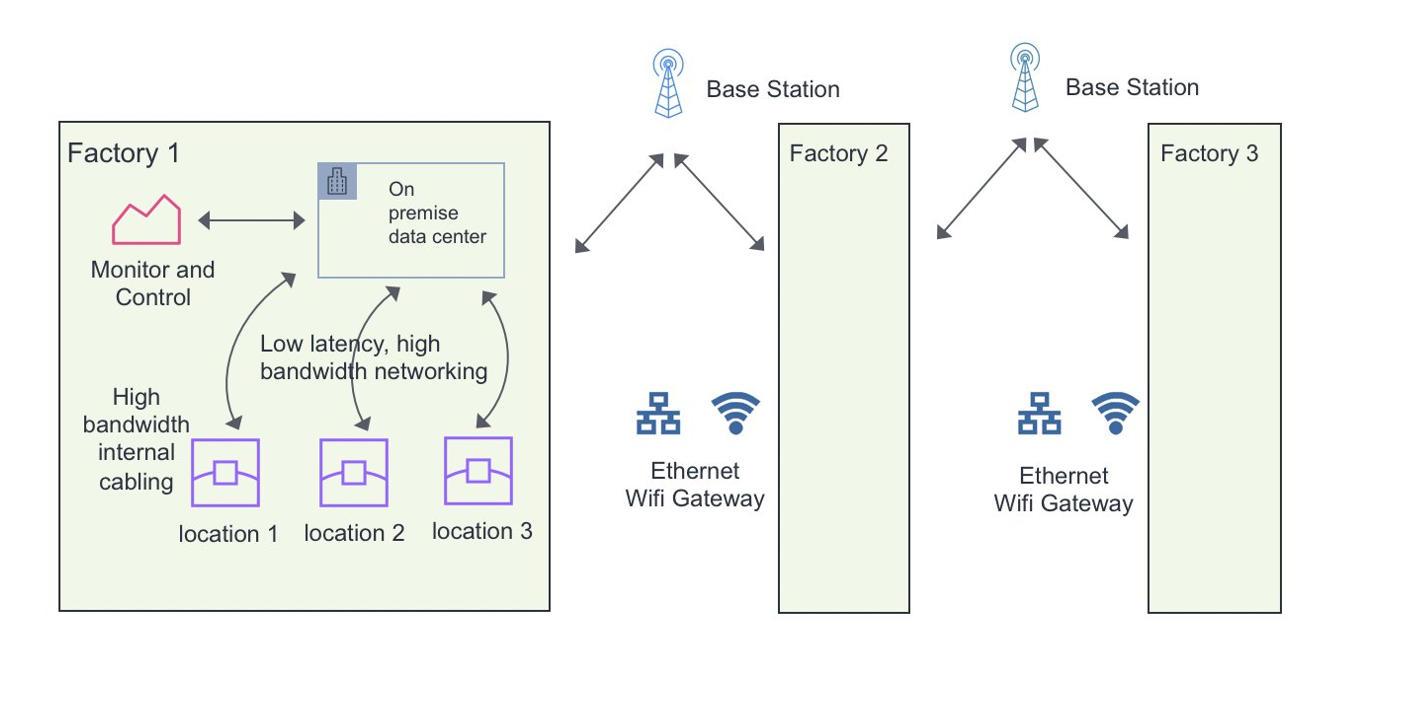
Challenges with current systems
The Manufacturing processes are complex and use different tools and methodologies to complete the operation. Every part in a finished product undergoes different stages and may even pass through different factories before it is assembled into a final product. Managing these processes require access to low latency and high bandwidth edge computing resources spread across the plants. Due to this, current implementations of Smart Factory solutions face multiple challenges:
- Maintenance of multiple edges: The plant quickly scales needing multiple edge devices and turns into a “massive cabling unit” that needs regular monitoring and management. From a security perspective, each of these onsite units needs to be individually protected against external attacks and data misuse.
- High capital investment: Multiple distributed computing clusters require capex in high performance computing and high speed communication system across the plants.
- High latency public cloud: The smart factory applications demand low latency and sometimes a large throughput. Based on datacenter locations and deployments zones, only certain applications of smart factory which are tolerant to high latency can leverage the cloud.
- Lack of agility and innovation: The reliance on a network of physical assets makes it difficult to respond quickly to market changes and leverage new technology innovations, like new AI models and access to high performance computing infrastructures.
- Integration Challenges: The Smart Factory solutions rely on various components provided by multiple vendors and integrating all those components to a unified solution takes lot of effort and expertise.
Evolution of Smart Factory applications and the impact of Edge
Last few decades we have observed the trend of Industries moving their software managing the control infrastructure to a public cloud, due to the improving Internet connectivity. The inherent benefit of public cloud with its elasticity, scalability, and pay as go model greatly accelerates the re-architecture and modernization of the software components used by the industrial processes. This push started with the vision of reducing time to market new products and reducing total cost of ownership (TCO). Public cloud is suitable for certain use cases where internet latency is of the order of 100’s of msec can be tolerated. But, we are observing the emergence of new technologies such as augmented and virtual reality, autonomous factories with IoT, where enormous amount of data is being produced at the edge of the network, which in turn increases the demand for real-time analytics, inference and real-time processing with the lowest latency possible.
One of the biggest benefits of AWS Wavelength vs onsite computing is the economic benefit brought about by alleviating the need to deploy local physical infrastructure and the operational overhead of managing the same. Public Edge closer to the factory sites allows customers to gain all the benefits of having compute and storage resources closer to edge where data is generated, without the need to own and operate their own infrastructure. Also, the onsite model doesn’t provide the required scalability and elasticity as provided by the cloud scale model. With the advent of 5G low latency, high bandwidth connections and access to Edge computing infrastructure like AWS Wavelength, the true vision of industry 4.0 can be achieved. Industries can also leverage 5G’s network slicing technology to obtain E-E network guarantee right from the Radio side all the way to the applications running in AWS Wavelength Zones.
Smart Factory with onsite computing
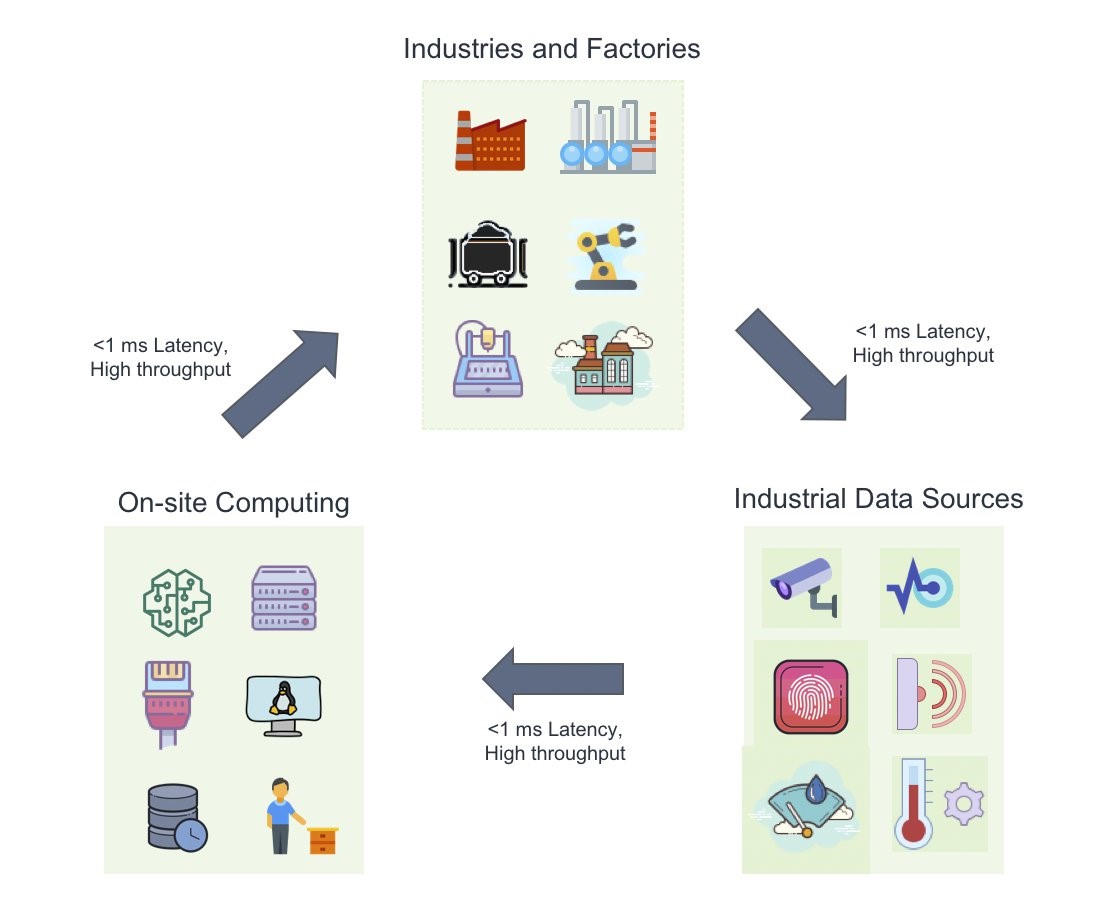
Smart Factory with a cloud computing model

*Location of the Factory plays a role in the latency to the Region **Only Control systems tolerating the higher latency can leverage Public Cloud
Smart Factory leveraging 5G with AWS Wavelength and AWS Region
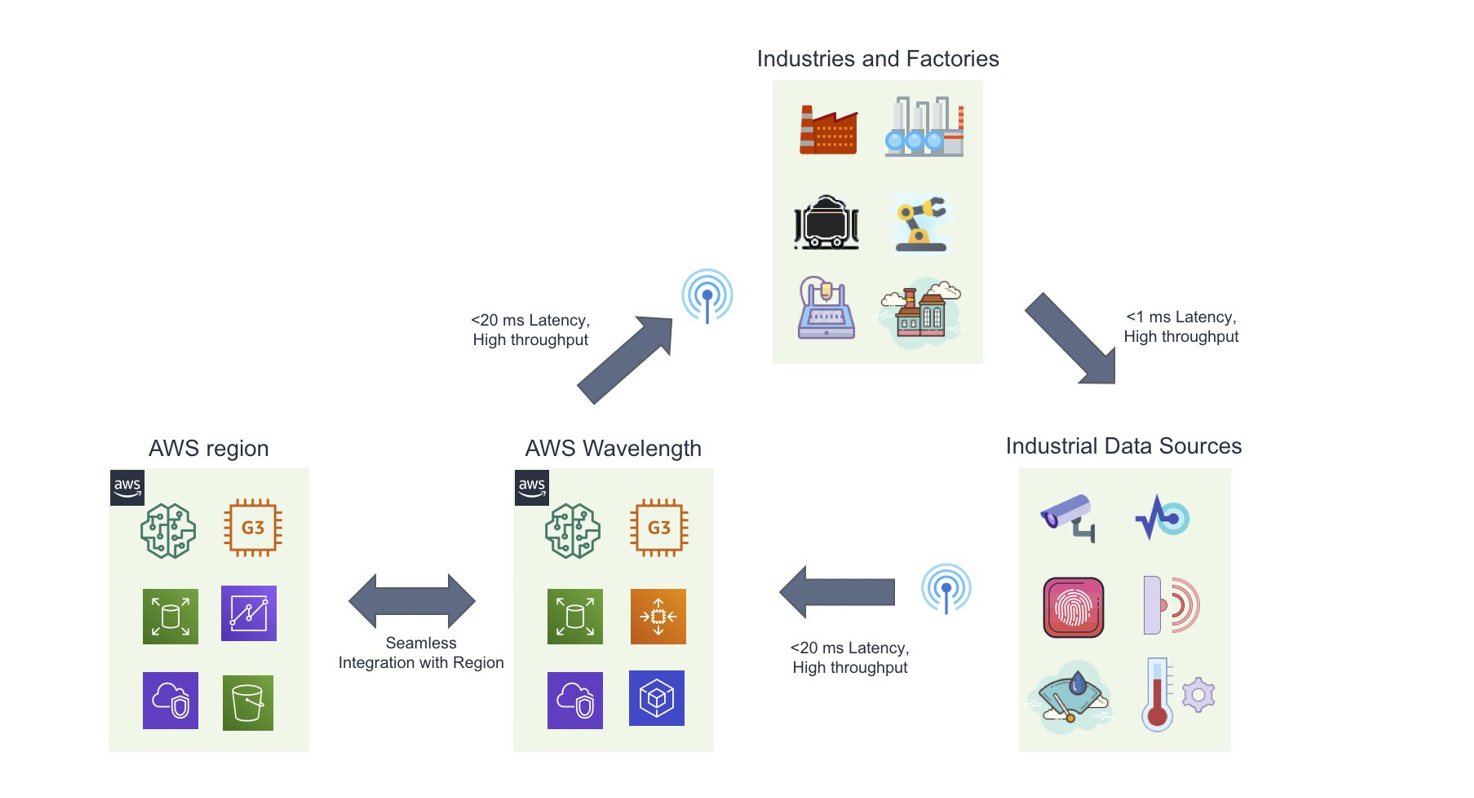
What is AWS Wavelength Zone? Why AWS Wavelength?
AWS Wavelength zones are AWS infrastructure deployments that embed AWS compute and storage services within the telecommunications providers’ data centers at the edge of the 5G networks. AWS Wavelength zones are also connected to a Region and provide seamless connectivity to access the breadth of AWS services in that Region. AWS Wavelength enables developers to build applications and deliver ultra-low latencies to any devices and end-users connected to the Mobile Carrier Service Provider network.. This enables smart factory applications that require ultra-low latencies including machine learning inference at the edge to run on AWS Wavelength.
Data generated at the Smart Factories can reach application servers running in Wavelength Zones without leaving the mobile provider’s network. This reduces the extra network hops to the Internet that can result in latencies of more than 100 milliseconds, preventing customers from taking full advantage of the bandwidth and latency advancements of 5G.
Wavelength delivers a consistent developer experience across multiple 5G networks around the world, allowing you to build the next generation of ultra-low latency applications using familiar AWS services, APIs, and tools. Developers simply extend your Amazon Virtual Private Cloud (Amazon VPC) to one or more Wavelength Zones and then use AWS resources like Amazon Elastic Compute Cloud (Amazon EC2) instances, Amazon Elastic Block Storage (EBS) volumes, AWS Elastic Container Service (Amazon ECS), Amazon Elastic Kubernetes Services (Amazon EKS), AWS Identity and Access Management (IAM), AWS CloudFormation, and AWS Auto Scaling to build, run, secure, manage, and scale their applications. Wavelength offers you the flexibility to scale up or scale down, and pay only for the resources that you use.
Overview of the TCS solution leveraging AWS Wavelength
TCS has built a Smart Factory solution in the area of quality and safety inspection. The Quality and safety inspection use cases demand high throughput and latency requirements, to transmit large volume of video files, get them processed and respond back to quality engineers or PLCs (Programmable Logic Controllers) to start or stop the assembly lines.
The current deployments rely heavily on GPU workloads inside the Plant adding costs to customers and additional risks on maintaining the workloads at plant. Now with AWS Wavelength bringing in AWS infrastructure and Services closer to the plant with ultra low latency access and higher bandwidth we tested our solutions to move the latency sensitive stack of the application from the plant locations to AWS wavelength zone. AWS Wavelength along with Mobile 5G connectivity not only provides the low latency access to Industries it also brings in the cloud model to the Edge.
Solution description
The Solution captures videos streams from IP based cameras and uses RTMP protocol to transmit it over the 5G network to application servers in AWS Wavelength Zone. 5G uplink provides the necessary B/W and latency profile to transfer these video streams, which are then processed by the G4 instances deployed in the Wavelength Zone. The Video is processed frame by frame, running the machine learning inference model to identify the defective units. The processed frame along with the inferred model output is sent back to console or device from which the user is monitoring the process can take a well-informed decision. The decision module can also send a direct command from application to start or stop the assembly line or process. The response back to PLCs, or assembly line demands low latency, which is provided by the 5G network. Leveraging the combination of 5G bandwidth, Low latency and proximity of plant to AWS Wavelength zones, we moved the workloads to wavelength zones. AWS Wavelength zone at the edge enables all nearby workloads to be moved to the same zone for all plants in that area.
Preceding, is the representation of our deployment architecture in AWS Wavelength zone.
Implementation of the Smart Factory solution on AWS Wavelength
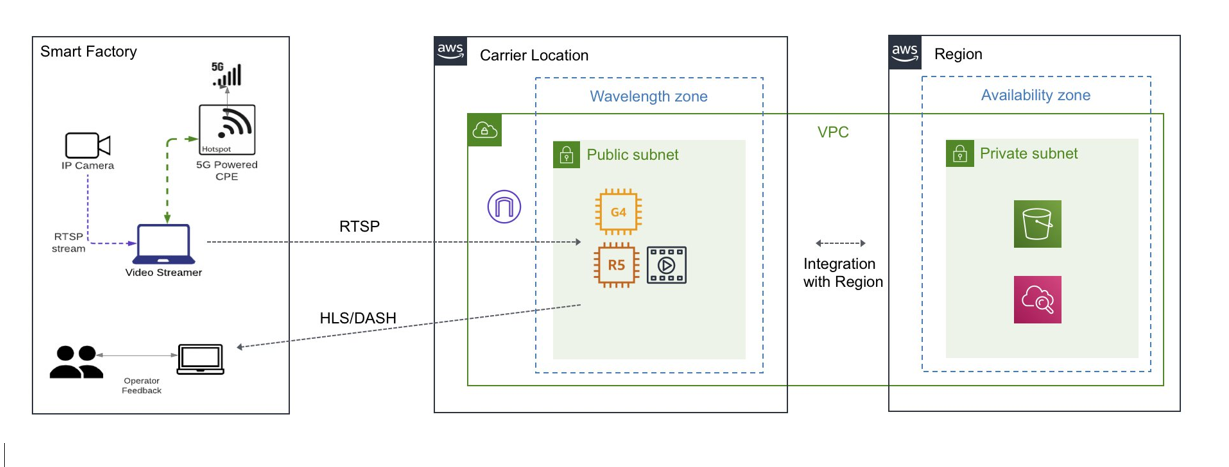
Simple flow diagram of the Smart Factory Testing

Key parameters we used to benchmark our Testing of the solution on AWS Wavelength
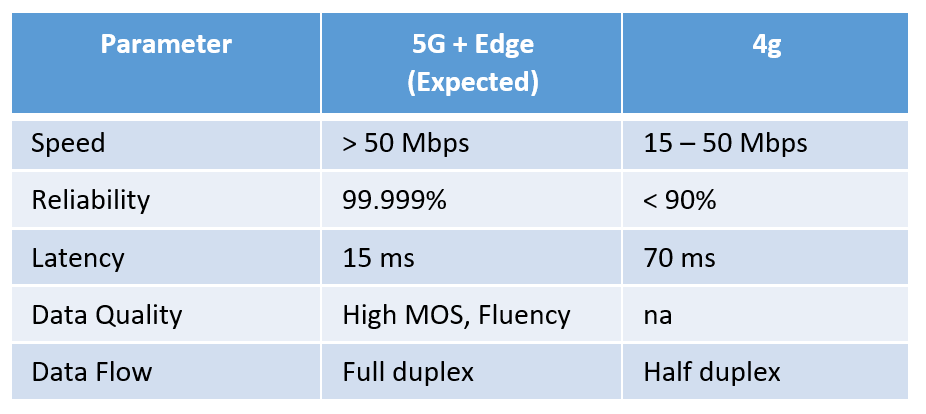
AWS Wavelength – Smart Factory solution validation results
TCS successfully deployed a critical workload of the smart factory solution on the AWS wavelength zone simulating a customer plant location, enabling real-time processing of the Video and image data, enabling remote inspection and monitoring on high speed assembly lines. This provides us the framework to realize a serverless plant for our customers with critical GPU workloads rendered from the Edge cloud powered by 5G and AWS Wavelength. AWS Wavelength in combination with 5G’s high bandwidth, low latency, and increased connectivity ensures a firm step towards true connected factories with data flowing seamlessly between machines and enabling digital twin-based Industrial automation.
Conclusion
5G connectivity providing low latency and high bandwidth access to AWS Wavelength Edge computing Zones will open opportunities for customers’ critical workloads to make full use of AWS infrastructure and Services. The idea of a Smart Factory has transformed manufacturing plants from systems that were automating discrete independent tasks into connected and intelligent systems that self-optimize activities across manufacturing processes. This transformation is primarily fueled by advancement in technology related to communication, edge computing and machine learning.
The Smart Factory capabilities will continue to rapidly evolve as long as it has access to next generation technologies. The 5G smart factory of the future will evolve into fully connected experience powered by AWS Wavelength Edge Cloud computing Infrastructure. It will lay the foundation of massive device connectivity and innovative technology experiences to near real-time automation and massive performance improvements, operational efficiencies, and increased safety in factories.